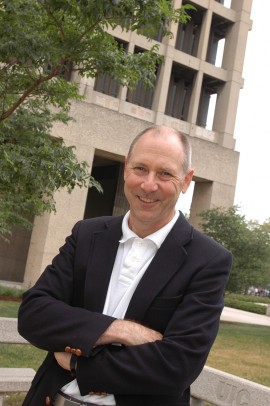Robert Bruegmann spreads the word on sprawl

Robert Bruegmann, emeritus professor of art history, architecture and urban planning, is planning a follow-up to Sprawl, his popular book. UIC Photo Services
When Robert Bruegmann came out with his groundbreaking book Sprawl in 2005, he was a little like Gordon Gekko declaring “Greed is good!” in the movie “Wall Street.”
The book, amazingly popular for an academic work, dared to suggest that sprawl isn’t a bad thing.
He also did related case studies of three households — in the central city, suburbs and exurbs — but the publisher made him leave that out.
Bruegmann wants to write a new book, in a journalistic style and no doubt even more popular, focusing on those studies.
But right now he’s way too busy.
“I have five or six large-scale projects,” said Bruegmann, emeritus professor of art history, architecture and urban planning.
One is a follow-up volume to his history of the Holabird & Roche architectural firm.
“They designed all the big skyscrapers of the ’20s — the Palmolive Building, the Board of Trade, the North Dakota state capitol,” he said.
Bruegmann also wants to write about Walter Netsch, author of UIC’s original master plan and architect for the east campus’ signature first buildings.
“I really need to do something on his comprehensive work,” he said. “I spent hours talking with Walter.”
Tapping a file cabinet at his side, Bruegmann added, “The material’s here, I need to do something with it.”
He also plans a book about Chicago’s built environment since 1945.
All that plus the Sprawl follow-up.
“Those are the things I should be working on,” he sighed.
“But I’m precluded from that by my promise to do the main text for a book on Art Deco Chicago.”
The book, for the Chicago Art Deco Society, will address Chicago’s importance to that movement.
“We didn’t have the Chrysler Building, but we did have buildings like the Palmolive. Chicago was never the first and was fairly conservative, and tended to standardize and be more economical.”
The city’s influence was expressed not just through buildings but also industrial and product design, turned out by companies like Motorola, Zenith, Schwinn and Radio Flyer.
“Chicago really brought Deco into the lives of Americans all over the country,” Bruegmann said.
In addition to Sprawl and the Holabird & Roche works, he has written books on Chicago architects Harry Weese and Ralph Johnson, A Guide to 150 Years of Chicago Architecture and an architectural history of Benicia, Calif., plus most of the text for about 10 other books.
“I’ve also done a lot of exhibitions, writing for newspapers, criticism for journals — especially Inland Architect — and CDs and DVDs when that was quite rare,” he said.
Sprawl was his best-selling book and his first to be translated into other languages. First was Mandarin, in 2008; the Spanish edition came out in 2012.
Bruegmann defines sprawl as “settlement that is less dense and goes farther out,” and argues it “is not hurting anybody in a dramatic way.”
Take driving automobiles, for example.
“People say it uses more energy and produces more greenhouse gases,” he said. “That’s not true.”
Cars carry an average of 1.25 passengers and are much more fuel-efficient than before. Buses, the overwhelming producer of public transit, get about two miles to the gallon.
“Which would be fine if the bus were filled,” Bruegmann said. “But the average number of people in a bus is nine.”
The upshot: per mile traveled, cars produce much less greenhouse gases.
Bruegmann first got interested in sprawl in Paris. The city is a leader in the movement to make hospitals healthier, largely by incorporating better air circulation into their design — the subject of his doctoral dissertation.
“Every time I went to the [Paris] airport, I went through dozens of miles of suburbs,” he said.
“Nobody wanted to talk about this. People in central Paris were more important than those outside. It was a class thing.”
Bruegmann is a product of suburban Pittsburgh. He earned his bachelor’s degree at Principia College, near St. Louis, and his Ph.D. at the University of Pennsylvania.
He taught at the Philadelphia College of the Arts for a year before joining UIC in 1977. He spent a half-dozen summers, including the first few at UIC, with the Historic American Building Survey.
Bruegmann was a visiting professor of architecture at MIT in 1981-82 and Columbia University in 1989-90 and 2001-2002.
He lives in Lakeview in a 20-story building, designed by Milton Schwartz, that was the first all-glass air-conditioned co-op in the city.
Bruegmann was awarded emeritus status in 2010, but little has changed — he continues teaching and advising grad students.
“I don’t go to faculty meetings, which has improved my quality of life enormously,” he said.
gwisby@uic.edu
